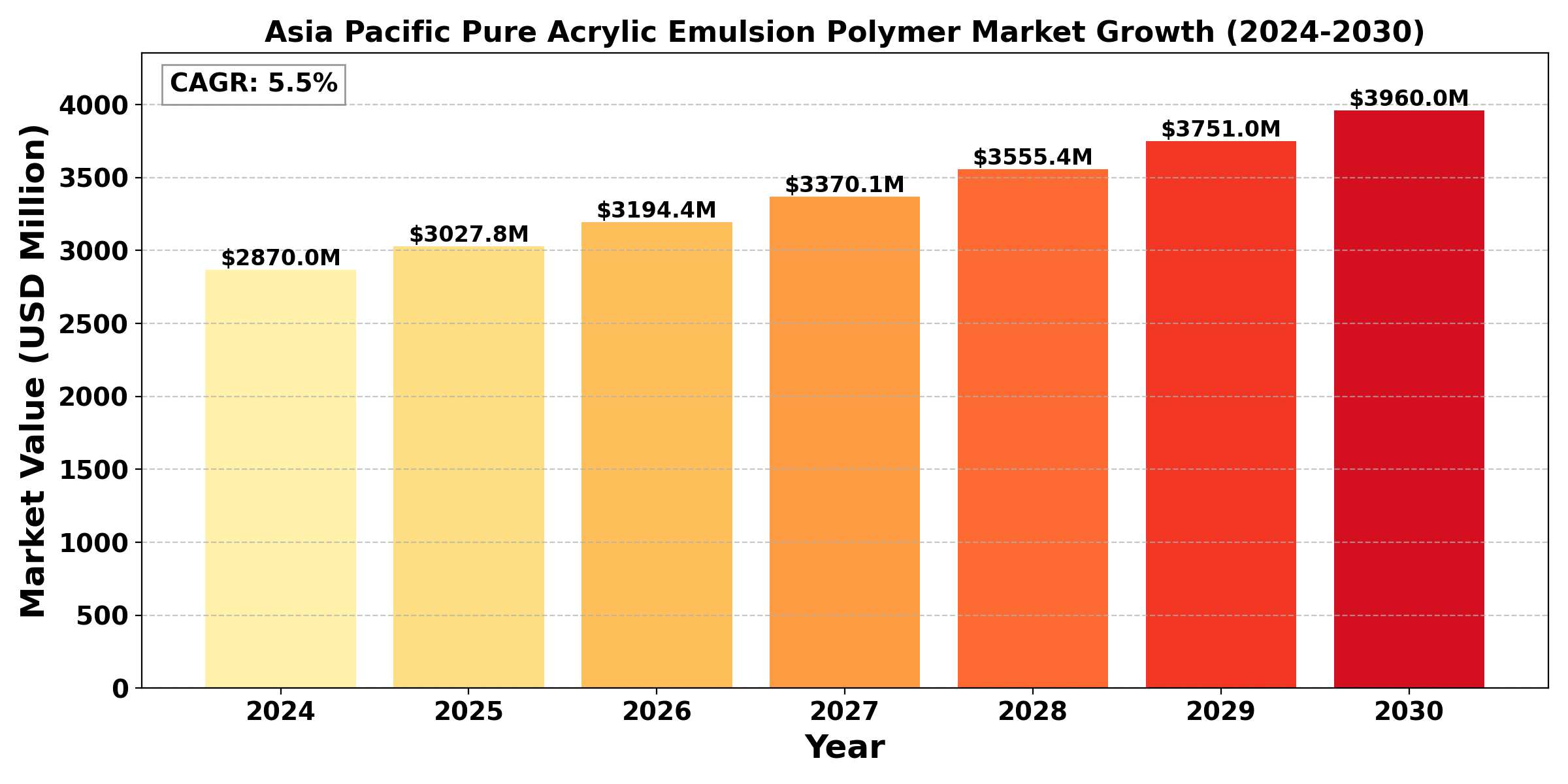TOP CATEGORY: Chemicals & Materials | Life Sciences | Banking & Finance | ICT Media
The Asia Pacific Pure Acrylic Emulsion Polymer market size was valued at US$ 2.87 billion in 2024 and is projected to reach US$ 3.96 billion by 2030, at a CAGR of 5.5% during the forecast period 2024-2030.
Pure acrylic emulsion polymers are water-based binders used in paints, coatings, adhesives, and sealants, offering excellent durability, weather resistance, and adhesion properties for various applications.
The Asia Pacific pure acrylic emulsion polymer market is experiencing robust growth, driven by the booming construction and automotive industries. China leads with a 50% market share, followed by Japan at 20% and India at 15%. In 2023, the paints and coatings sector consumed 55% of total production, with adhesives at 25% and textiles at 15%. The market saw a 12% increase in demand for low-VOC formulations due to stricter environmental regulations. Key players include Arkema S.A. (France) and Nippon Shokubai Co., Ltd. (Japan), collectively holding a 35% market share in the region. The industry is investing in bio-based acrylic technologies, with an 18% increase in R&D spending on sustainable monomers in 2023. Challenges include raw material price volatility, leading to a 7% fluctuation in production costs. The trend towards smart coatings has driven a 15% growth in demand for functional acrylic polymers with self-healing or anti-microbial properties. The market is benefiting from the expansion of the DIY sector, with a 20% increase in consumer-grade pure acrylic emulsion products.

Report Includes
This report is an essential reference for who looks for detailed information on Asia Pacific Pure Acrylic Emulsion Polymer . The report covers data on Asia Pacific markets including historical and future trends for supply, market size, prices, trading, competition and value chain as well as Asia Pacific major vendors¡¯ information. In addition to the data part, the report also provides overview of Pure Acrylic Emulsion Polymer , including classification, application, manufacturing technology, industry chain analysis and latest market dynamics. Finally, a customization report in order to meet user's requirements is also available.
This report aims to provide a comprehensive presentation of the Asia Pacific Pure Acrylic Emulsion Polymer , with both quantitative and qualitative analysis, to help readers develop business/growth strategies, assess the market competitive situation, analyze their position in the current marketplace, and make informed business decisions regarding Pure Acrylic Emulsion Polymer . This report contains market size and forecasts of Pure Acrylic Emulsion Polymer in Asia Pacific, including the following market information:
We surveyed the Pure Acrylic Emulsion Polymer manufacturers, suppliers, distributors and industry experts on this industry, involving the sales, revenue, demand, price change, product type, recent development and plan, industry trends, drivers, challenges, obstacles, and potential risks.
Total Market by Segment:
The report also provides analysis of leading market participants including:
Asia Pacific Pure Acrylic Emulsion Polymer Market – FAQs
1. What is the current market size of the Asia Pacific Pure Acrylic Emulsion Polymer market?
2. What is the projected market size by 2030?
3. What is the CAGR of the Asia Pacific Pure Acrylic Emulsion Polymer market from 2024 to 2030?
4. What are Pure Acrylic Emulsion Polymers used for?
These polymers are widely used in:
Adhesives and sealants
Coatings and paints
Textile finishes
Paper coating
Construction materials
5. What factors are driving market growth in the Asia Pacific region?
Increasing demand from the construction and automotive sectors
Growth in paint and coatings industry
Rising awareness about eco-friendly and water-based polymers
Expansion of manufacturing and industrial activities
Key Points of this Report:
Reasons to Purchase this Report: